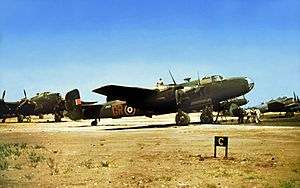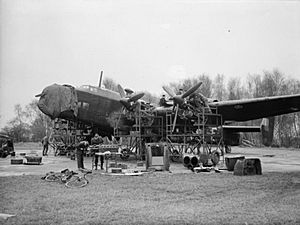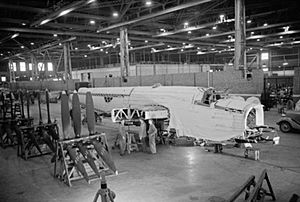British shadow factories facts for kids
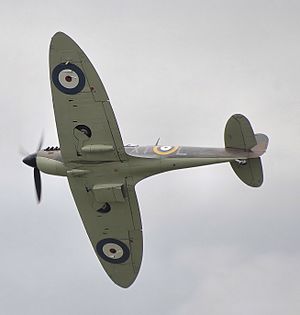
During the time leading up to World War II, the British government created a special plan called the Shadow Scheme. This plan aimed to quickly build many more airplanes. They did this by using the skills and factories of car companies. These new factories were called British shadow factories.
The word "shadow" didn't mean they were secret. Instead, it meant these new factories worked closely alongside existing car factories. They used the same skilled workers and managers from the car industry. This helped them learn how to build planes and engines very quickly.
The government started this plan in 1935. A special group was formed in 1936 to manage making planes and their parts. Herbert Austin, a famous car maker, helped lead this big project.
Contents
Why Were Shadow Factories Needed?
It was clear that Britain needed many more airplanes to be ready for war. The existing aircraft factories couldn't build them fast enough. The idea was to use the car industry's experience in making things quickly and efficiently.
Building Planes Faster
These factories couldn't be kept secret, even though they were camouflaged (hidden) once the war started. They were built right next to car factories. This made it easy to share technology and workers. Car companies ran these new factories, helping to produce war materials.
How the Plan Worked
The Shadow Scheme had two main parts:
- New Factories: The government built and equipped nine brand new factories. Car companies then learned how to make airplane parts. This way, if war started, these new factories could immediately begin full production.
- Expanding Old Factories: Existing car factories were also made bigger. This allowed them to switch easily to making aircraft parts or to produce more of them.
The government provided money to build these new facilities. A very important part of the plan involved Rolls-Royce. Their Merlin engine powered many key British aircraft. Other companies like Bristol also made important engines.
The first car makers chosen to help build engines were Austin, Daimler, Humber, Singer, Standard, Rover, and Wolseley.
Amazing New Buildings
The new factory buildings were designed to be very efficient. They were huge sheds, sometimes over 2,000 feet (600 meters) long. They had lots of light and wide, clear pathways. One of the biggest was Austin's Cofton Hackett factory, built next to their Longbridge plant. It covered about 20 acres (8 hectares)! Later, even more factory space was added for building plane bodies and flight testing.

By late 1937, five shadow factories in Coventry were already making parts for the Bristol Mercury engine. By early 1938, two of these factories were building complete aircraft bodies. In July 1938, the first bomber built entirely in a shadow factory (by Austin) took its first flight.
The plan kept growing. By 1943, the government took over building even more factories for aircraft production.
- Factories Across the UK and Beyond
The third wave of shadow factory construction reached Scotland. A factory in Hillington started producing Rolls-Royce Merlin engines there. Similar plans were also started in other countries like Canada, Australia, New Zealand, and South Africa.
List of Shadow Factories
Here are some of the main shadow factories and what they produced during the war:
| Location | Manager for Ministry of Aircraft Production | Original use | Wartime production | Today |
|---|---|---|---|---|
| Acocks Green, south of Birmingham | Rover Aero | Westwood family's market garden | Parts for Bristol Hercules radial engine | Redeveloped as housing |
| Bankfield Shed, Barnoldswick | Rover Aero | Weaving shed | Jet engine development | Handed over to Rolls-Royce in 1943 |
| Banner Lane, Coventry | Standard Aero No. 2 |
Golf course | Bristol Hercules sleeve valve radial engines | Ferguson then Massey Ferguson tractors. Closed 2002. Now housing |
| Blythe Bridge, Staffordshire | Rootes Securities | Blenheim, Beaufort, Beaufighter | Indesit cookers | |
| Lostock, Bolton, Lancashire | de Havilland | Airscrews | ||
| Browns Lane, Coventry | Daimler | Farmland | Aero engines, Aircraft sub-assemblies | Jaguar's Browns Lane plant, demolished 2008, now housing and an industrial estate |
| Burtonwood, Warrington | Fairey Aviation | Assembled and modified imported American aircraft | ||
| Canley-Fletchamstead Hy, Coventry | Standard Aero No. 1 |
Vacant land on Standard's Canley site | Bristol Beaufighter De Havilland Mosquito |
Standard Motor Company demolished after closure in 1980. Now housing |
| Canley-Fletchamstead Hy, Coventry | H M Hobson | Vacant land on Standard's Canley site | Carburettors for aircraft engines | Standard Motor Company demolished after closure in 1980. Now housing |
| Castle Bromwich, West Midlands | Nuffield Organization then Vickers | Farm/Sewage works | 11,989 Supermarine Spitfires, Avro Lancaster | Dunlop Research Centre, Fisher and Ludlow — Pressed Steel, Jaguar |
| Caversham (Star Road), Berkshire | Unknown | Purpose-built factory | Spitfire fuselages and engines | Housing |
| Christchurch, Hampshire | Airspeed | Airspeed Oxford | Mixed retail units | |
| Clayton-le-Moors, Accrington | Bristol Aeroplane Company | Aircraft engines | Sold to English Electric, now the GEC industrial estate | |
| Cofton Hackett, East Works, Longbridge | Austin | Farmland in Groveley Lane | Aero engines, Bristol Mercury and Pegasus Aircraft production – Fairey Battle, Stirling, Avro Lancaster, vickers Wellingtons |
Redeveloped as housing |
| Coventry, Stoke Aldermoor Lane | Humber | Aero engines | ||
| Crewe, Cheshire | Rolls-Royce | Farmland | Rolls-Royce Merlin | Bentley Crewe |
| Cwmbran, South Wales | Lucas | Farmland | Aircraft turrets | |
| Distington, Cumbria | High Duty Alloys Ltd | Farmland | Aircraft parts made of Hiduminium | Abandoned |
| Wheatley Hall Road, Doncaster | Crompton Parkinson | Greenfield site | .303 rifle ammunition | International Harvester tractors, site now redeveloped. |
| Drakelow Tunnels, Kidderminster | Rover Company | Hills | Parts for Bristol Mercury, Pegasus and Rolls-Royce Meteor engines | Preserved as former Cold War site |
| Hillington, Glasgow | Rolls-Royce | Farmland | Rolls-Royce Merlin | Closed 2005, redeveloped as an industrial estate. |
| Valley Works, Langley Mill, Derbyshire | Collaro | Various munitions items | Vic Hallam prefabricated buildings | |
| Leavesden, Hertfordshire | de Havilland | Greenfield site | De Havilland Mosquito | Used by Rolls-Royce to manufacture helicopter engines, now used as a film studio |
| Melton Road Works, Leicester | British Thomson-Houston | Aircraft magnetos and starter-motors | Used as a lamp factory by AEI which later sold its lighting interests to Thorn | |
| Leyland, Lancashire, BX Factory | Leyland Motors | Greenfield site | Armoured Vehicle production 1940-1945 | Commercial vehicle production post war, site now re-developed |
| Pine End Works, Lydney, Gloucestershire | Factories Direction Ltd. | Plywood for the aircraft industry | Demolished | |
| Meir, Stoke-on-Trent | Rootes Securities | Air Field | Harvard assembly, Mustang modifications | Aerodrome, now housing |
| Reading, Berkshire | Vincents | Coachworks | Spitfire parts | Thames Tower office block |
| Reading, Berkshire | Great Western Motors | Garage | Spitfire parts | Retail park |
| Ryton, south east of Coventry | Humber | Farmland | Aircraft engines | Car production, now redeveloped |
| Salisbury, Wiltshire | Supermarine | Spitfire assembly | redeveloped as housing | |
| Samlesbury Aerodrome | English Electric | Handley Page Halifax | BAE Systems aircraft factory | |
| Lode Lane, Solihull | Rover | Farmland | Parts for Bristol Hercules radial engine | Land Rover Solihull manufacturing |
| Speke Airport, Lancashire | Rootes Securities | Speke Airport | Bristol Blenheim, Handley Page Halifax heavy bomber aircraft | Dunlop tyres, footwear, golf and tennis balls, now redeveloped as industrial estate |
| Staverton, Gloucestershire | Rotol | Staverton Airport | Variable pitch airscrews | Rotol Gloucester Airport |
| Errwood Park, Stockport | Fairey Aviation | Beaufighters then Handley Page Halifax bombers | ||
| Trafford Park, Manchester | Ford | Derelict motor assembly plant | Rolls-Royce Merlin | Modern industrial uses |
| Mosley Road, Trafford Park, Manchester | Metropolitan-Vickers | Avro Lancaster | Modern industrial uses | |
| Willesden, North London | Freestone and Webb | Coach builders | Wing tips for the Spitfire | Housing |
| Woodstock Mill, Oldham, Lancashire | H M Hobson | Cotton mill | Carburettors for aircraft engines | Seddon Atkinson truck factory, now used as a distribution centre |
| Moorcroft Mills, Ossett | Rotol | Hepworth Brothers Limited Textile mill | Variable pitch airscrews | Later sold to Jonas Woodhead and Son, manufacturer of vehicle shock absorbers, site now re-developed for housing |
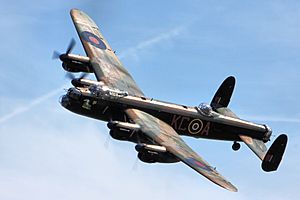
Spreading Out Production
The government also wanted to spread out where things were made. This was called "strategic dispersal." The idea was to reduce the risk of all production stopping if one major factory was bombed. New smaller factories were built in different areas, including places with high unemployment.
London Aircraft Production Group
In 1940, a group called the London Aircraft Production Group (LAPG) was formed. This group brought together many different factories and workshops in and around London. These included companies that usually made cars or buses.
Their main job was to build Handley Page Halifax bombers for the RAF. They also made ammunition, gun parts, and armored vehicles. London Transport (the company that runs London's buses and trains) led this group. They used their own workshops and a new factory with an airfield at Leavesden, Hertfordshire. This allowed them to build, assemble, and test the Halifax bombers.
By March 1945, the LAPG included eight main members, even some with factories outside London. These companies worked together to make different parts of the Halifax bomber. For example:
- London Passenger Transport Board made the middle section of the plane.
- Chrysler Motors made the back part of the plane.
- Express Motor and Body Works made the wings and tail.
- Duple Bodies and Motors made the front part of the plane.
- Park Royal Coachworks made the outer wings.
From May 1941, Fairey Aviation Company in Stockport took over putting all the parts together and doing the test flights.
At its busiest, the LAPG involved 41 factories and smaller units. They worked with 660 other companies and had over 51,000 employees. Many workers were new to aircraft production, and more than half were women.
This huge effort meant they could produce up to 200 Halifax bombers every month. The group built about 40% of all the heavy bombers made in Britain during the war. Halifax bombers dropped over 200,000 tons of bombs during the war.
Other Dispersal Plans
Because the shadow factory plan worked so well, other military production areas also started their own dispersal plans:
- Alvis, a car company, had 20 sites in Coventry alone. They made vehicles and weapons. When their main factory was destroyed in 1940, they quickly started working from eight different dispersed factories.
- Rover managed six shadow factories for the government and ran eighteen of their own dispersed factories.
- When the Birmingham Small Arms (BSA) factory was bombed in 1940, it caused delays in making rifle barrels and machine guns. BSA then spread its production to 67 factories across Britain. They employed 28,000 people and made more than half of Britain's small arms during the war.
List of Dispersal Factories
Here are some examples of dispersal factories:
| Location | Owner | Original use | Wartime production | Today | |
|---|---|---|---|---|---|
| Whitelands Mill, Ashton-under-Lyne | A. V. Roe & Co. | Cotton Mill | Aircraft parts | Abbey Thermosets | |
| Axminster, Devon | Axminster Carpets | Carpets | Stirrup pumps | Carpets | |
| Blackpool, Lancashire | Vickers | RAF Squires Gate | Bombers | Blackpool International Airport | |
| Belfast, Northern Ireland | Short & Harland | Bombers and Flying Boats | Short Brothers | ||
| Broughton, Flintshire | Vickers | Farmland | Aircraft production | Airbus Industrie, Broughton | |
| Hargher Clough Mill, Burnley | Joseph Lucas Ltd. | Cotton weaving shed | Aircraft parts | Demolished | |
| Byley, Cheshire | Vickers | Vickers Wellington | |||
| Wren Mill, Chadderton | Cossor | Cotton Mill | CRTs for Radar | Demolished, replaced by an Asda supermarket | |
| Orchard Mill, Darwen | ICI | Cotton Mill | Perspex mouldings for aircraft canopies and windows | Lucite plastics | |
| Distington, Cumbria | High Duty Alloys Ltd | Farmland | Aircraft parts made of Hiduminium | Abandoned | |
| Crewe Toll, Edinburgh | Ferranti | Electrical optical and mechanical assemblies | Ferranti | ||
| Ivy Mill, Failsworth | A. V. Roe & Co. | Cotton Mill | Aircraft parts | ||
| Grantham, Lincolnshire | BMARC | Farmland | Hispano-Suiza 20 mm cannon | Redeveloped | |
| Grappenhall, near Warrington | Metropolitan-Vickers | Leather tannery | Sintered carbides for cutting tools and armour piercing projectiles | Demolished and replaced by housing. | |
| Hawarden, Flint | Vickers | Farmland | 5,540 Vickers Wellingtons and 235 Avro Lancasters | Airbus Industrie, Broughton | |
| Hawthorn, Box and Corsham, Wiltshire | Bristol Aeroplane Company | Quarry, Bath stone | Intended for aircraft engines but little used | Became Central Government War Headquarters, closed 2005 | |
| Hawthorn, Corsham, Wiltshire | BSA | Quarry, Bath stone | M1919 Browning machine gun | Abandoned under RAF Rudloe Manor | |
| Hednesford, Staffordshire | Roller bearings | Fafnir Bearing | |||
| Ilminster, Somerset | Standard Telephones and Cables | Rope Works | Radio Valves | ||
| East Lancashire Road, Liverpool | Napier & Son | Aircraft engine production, Napier Sabre | English Electric then industrial estate | ||
| Linwood, Paisley Scotland | Beardmore's | Farmland | High-grade Steel for guns | Pressed Steel then Rootes Group's North Plant | |
| Cowbridge House, Malmesbury, Wiltshire | EKCO | Country mansion | Radar equipment | Demolished and replaced by housing. | |
| Newcastle-under-Lyme, Staffordshire | BSA | Farmland | Hispano-Suiza 20 mm cannon | Redeveloped | |
| Newtown, Powys, Wales | Accles & Pollock | Farmland | Tubular steel: aircraft frames, gun barrels | Industrial estate | |
| Northampton (Duston) | British Timken | Farmland | Roller bearings | Opened 1941, closed 2002 – moved to Poland. Demolished and replaced by housing. | |
| Farme Cross, Rutherglen | EKCO | Electrical components | Used as a sewing factory, now demolished | ||
| Sawbridgeworth, Hertfordshire | Walter Lawrence plc | Existing construction joinery workshops | Mosquito wings | Housing development | |
| Cape Mill and Duke Mill, Shaw, Oldham | Marconi-Osram Valve, a subsidiary of GEC | Cotton Mills | CRTs for Radar, radio valves, instruments | Used as an Osram lamp factory, now closed | |
| South Marston, Swindon, Wiltshire | Phillips & Powis Aircraft | Farmland | Aircraft production, largely Miles Master, shadowing Woodley factory | Honda car plant | |
| Stonehouse, Gloucestershire | Sperry Gyroscope Co. Ltd | Textile Mill | Gyroscopes and instruments | Industrial estate | |
| Stonehouse, Gloucestershire | Hoffmann Ball Bearings | Farmland | Ball bearings for aero engines | Industrial estate | |
| Swaythling, Hampshire | Cunliffe-Owen Aircraft | Farmland | Parts for the Supermarine Spitfire | Ford Southampton plant | |
| Swindon, Wiltshire | Plessey | Electrical components | Plessey | ||
| Treforest, South Wales | Smiths Instruments | KLG spark plugs | |||
| Treforest, South Wales | Standard Telephones and Cables | Quartz crystals | |||
| Tubney Wood, Oxfordshire | Nuffield Mechanisation | Bofors guns | |||
| Weston-super-Mare, Somerset | Bristol Aeroplane | Beaufighter | |||
| Yeadon, Leeds, Yorkshire | Avro | Avro York | Leeds Bradford Airport | ||
| Ystradgynlais, South Wales | Smiths Instruments | Clocks and watches |
How Many Factories?
By June 1939, 31 shadow factories were either finished or being built. The Air Ministry was in charge of 16 of these, and 11 were already working at full speed. Many Bristol engines and aircraft were being made in these government-owned shadow factories.
By February 1944, there were 175 "managing agency schemes" or shadow factories in total. This shows how important they were to Britain's war effort.
See also


